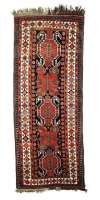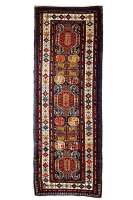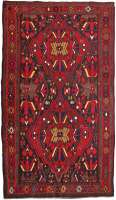Today.Az » Arts & Entertainment » Carpet Museum displays Buynuz carpets
21 October 2020 [14:17] - Today.Az

By Azernews
By Laman Ismayilova Azerbaijan Carpet Museum continues to highlight Azerbaijan's carpet weaving art. The museum displayed the 19th-20th century Buynuz carpet. The main production centers of Buynuz carpets woven in Karabakh were Horadiz and other carpet weaving centers in Fuzuli. Old carpet weavers often call this carpet Horadiz. Buynuz (horn) elements, patterns of the carpet's central field are traditionally depicted horizontally one after another. The asymmetric design of these buynuz elements gives the carpet vividness and also allows to weave them in any size. The variety of colors of buynuz does not violate the overall harmony of carpet colors. Since ancient times, the horn has been considered a symbol of courage and bravery. Horn images are often found in carpet weaving, wood and felt products of the Turkic peoples. Even today, in some regions of Azerbaijan, one can find the head of a horned animal hung on door and gate as a symbol of courage. The museum also exhibited Bahmanli carpets of Karabakh region. The woolen carpets are dating back to the late 19th and early 20th century. In addition, the Carpet Museum provided insight into one of the famous Karabakh kilims woven in Zangilan. The central field of the colorful kilim is decorated with two large medallions with slits. The stylized palmettes surround medallions. These kilims were often used as a canopy. The central field of the colorful kilim is decorated with two large medallions with slits. The stylized palmettes surround medallions. These kilims were often used as a canopy. The Carpet Museum opened its doors in 2014 at Baku Seaside Park. All carpets were transferred to the museum's new location. Now, the museum hosts multiple events, including international symposiums, conferences and various exhibitions. In 2019, the museum received the national status for its significant contribution in popularization and promotion of the Azerbaijani Carpet Weaving Art. National Carpet Museum holds more than 14,000 exhibits of the finest Azerbaijani carpets. The Land of Fire has seven carpet producing regions including Baku, Shirvan, Guba, Tabriz, Karabakh, Ganja and Gazakh and each of them has its own technology, typical patterns and colors. According to their technical aspects, Azerbaijani carpets are classified as flat-woven (pileless) and knotted (pile). The flat-woven carpets are linked to the earlier period of carpet weaving. There are several kinds of pileless carpets such as Shadda, Verni, Jejim, Zilli, Sumakh, Kilim and Palas. Shadda is a flat weave carpet, made primarily in Nakhchivan, Agdam, Gubadly, Agjabedi. The artistic composition of shadda made by complicated whipping, as well as its constituents have a complex form. One of the most widely spread type of the flat-weave carpet is "verni". The key pattern of "verni" is the S-element. Its shape varies, it may resemble both figure 5 and letter S. This element means "dragon" among the nomads and “water” among the village people. According to the ancient believes, a dragon featuring carpet would protect the family from foul weather. Agjabedi, Barda, Aghdam, Nakhchivan are the centers of this type of pileless carpets. Jejims are woven on simple horizontal looms by narrow stripes 30–35 cm wide and 15–10 cm long. The resulting product is a cloth to be used as a wall carpet, a bedding coverlet, or curtains. The major jejim production centers are Barda, Nakhchivan, Zangilan, Shusha, Shamakha. Zilli carpet is characterized by stylized forms of animals and vegetal elements. In terms of their composition and pattern the Azerbaijani zillis are very diverse. They feature the images of large elements in the shape of big lozenges, paired horns, various stylized elements. The Sumakh carpets have become widely spread and recognized over the last few centuries. Since the 18th century, they have been made in country's Guba and Gusar regions. The Sumakh carpets feature the diverse stylized vegetal motifs, various geometrical elements such as large hexahedral, square, rhomboid medallions. Kilim is the most widespread type of flat-woven carpets. They are made by passing the weft through the warp using the technique of compound interweaving. Kilim is characterized by a slot-like gap (opening) around the geometrical patterns. The technique of kilim weaving predetermines the pattern shapes in the form of a lozenge, triangle, and trapezium. Images of animals, birds and humans are geometrized in kilims. Kilims of different regions are distinguished by their composition, pattern, and colors. In terms of their technical peculiarities kilims can be classified into five major groups based on the area of production: Kazakh, Karabakh, Absheron, Shirvan and Tabriz kilims. Palas is one of the widely spread flat-weave carpets. The palas weaving process consists in passing the weft through the warp by a simple technique. The weavers decorate the palas by traditional patterns in the form of horizontal stripes commonly used throughout Azerbaijan. As a rule, the palas is not framed by a border.




|